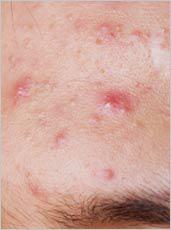 Benzoyl peroxide is used in a number of household products that clean and whiten. It’s also considered a medication and is used for treating skin issues. Benzoyl peroxide can be found in pharmacies or in the medication section of your supermarket. In some cases, your doctor will prescribe a more potent amount of benzoyl peroxide that can’t be bought over the counter.
Benzoyl peroxide is used in a number of household products that clean and whiten. It’s also considered a medication and is used for treating skin issues. Benzoyl peroxide can be found in pharmacies or in the medication section of your supermarket. In some cases, your doctor will prescribe a more potent amount of benzoyl peroxide that can’t be bought over the counter.
Now you may have heard of benzoyl peroxide while searching for acne remedies. That’s because it’s widely used for treating mild to moderate cases of acne on both the face and body, and is a common ingredient in face cleansers, scrubs and body washes. Because of this, benzoyl peroxide often gets misconstrued as an acne cure-all because it’s one of the most powerful treatments used for preventing pimples.
The key word is “prevent” since it does not erase acne from one’s face. This type of peroxide works because it’s able to break down and destroy bacteria that causes acne. But benzoyl peroxide doesn’t have anti-inflammatory properties, which are important for clearing up any inflamed pimples you currently have. However, with proper usage it can still be a helpful tool to keep handy to prevent pimples from forming.
Uses for Benzoyl Peroxide
As we mentioned before, Benzoyl peroxide is used to prevent mild to moderate acne by lowering the amount of bacteria that causes pimples. Unfortunately, skin that’s affected becomes dry and will peel; however, this minor problem will heal in time. In some cases, a doctor may prescribe different benzoyl products that can’t be purchased over the counter because it’s essentially a medicine. Depending on your personal needs, your doctor may suggest a prescription or an over-the-counter variety that may be of lower potency.
How to use Benzoyl Peroxide for Acne
Acne can pop up all over the body, including your upper arms, shoulders, chest, face and back, which keeps a lot of people from wearing tank tops or strapless dresses. To clear up areas affected by zits with benzoyl peroxide, first wash your skin with a face cleanser. The next step involves patting your face dry with a clean towel; it’s crucial to use a clean towel so as not to add any more bacteria onto your face. Patting your skin instead of rubbing it with the dry, clean towel reduces irritation that can be caused by friction.
Topical Products with Benzoyl Peroxide
Use a benzoyl peroxide cream or gel to apply on the areas of your body that are affected by acne before bed (this includes your face). Letting the product dry on your skin is important so that the bacteria is sure to be taken care of. Gently wash the benzoyl off in the morning using a gentle cleanser – unless the product’s label specifies otherwise.
Dosage is based on your medical condition and response to therapy. Improvement in acne is usually seen after three weeks of use, and you’ll get maximum benefits after 8-12 weeks of use. Apply this medication regularly in order to get the most benefit from it. To help you remember, use it at the same time(s) each day. If your condition persists or worsens, make sure to contact a doctor as quickly as possible.
If you choose a benzoyl peroxide medicated pad or sponge, you’ll still want to cleanse the surface dirt off of your skin before using the benzoyl product; use the pad or sponge as directed on the label. Depending on the product, you will need to rinse and then pat dry before continuing with your normal routine.
Benzoyl Peroxide Cleansers
If using creams or gels seems like too long of a process for you, try using a benzoyl peroxide cleanser. Wet the skin where you tend to develop pimples, and then continue using a light touch to rub the cleanser onto your skin (should be a lather) for about 15 seconds; rinse the skin well before patting dry. You can use benzoyl peroxide cleansers such as liquid, pad, or bar twice a day if necessary. Assuming your skin becomes too dry, rinse the product off sooner or use the cleanser less often. If your skin is experiencing a harsh side effect, talk with your doctor about finding a solution.
Shaving Cream and Benzoyl Peroxide
Benzoyl peroxide is even found in some shaving creams. The process of using this form of the medication is no different than using a shave cream that does not contain benzoyl peroxide. Wet the area to be shaved before applying small amounts of the product onto your skin. Rinse your skin with warm water and finish by patting the skin dry. Use a moisturizer to re-hydrate your skin and keep oil glands from becoming unbalanced.
Precautions for Benzoyl Peroxide
As with any form of medication or product, there are a few precautions that need to be taken before or during your use of benzoyl peroxide. Keep this product out of your eyes, mouth, or nose since it can cause irritation. Also, don’t apply benzoyl peroxide to broken skin; if any of the aforementioned scenarios happen, flush the area with water immediately.
When using benzoyl peroxide, it’s best to take precautions for your floor, furniture, and hair as it can leave bleach stains if left unattended. One more thing we’d like to mention is that you should wear an old shirt or a towel around your shoulders to avoid ruining clothing.
Benzoyl Peroxide: Uses & Cautions is a post from: Health Care and Beauty Blog
